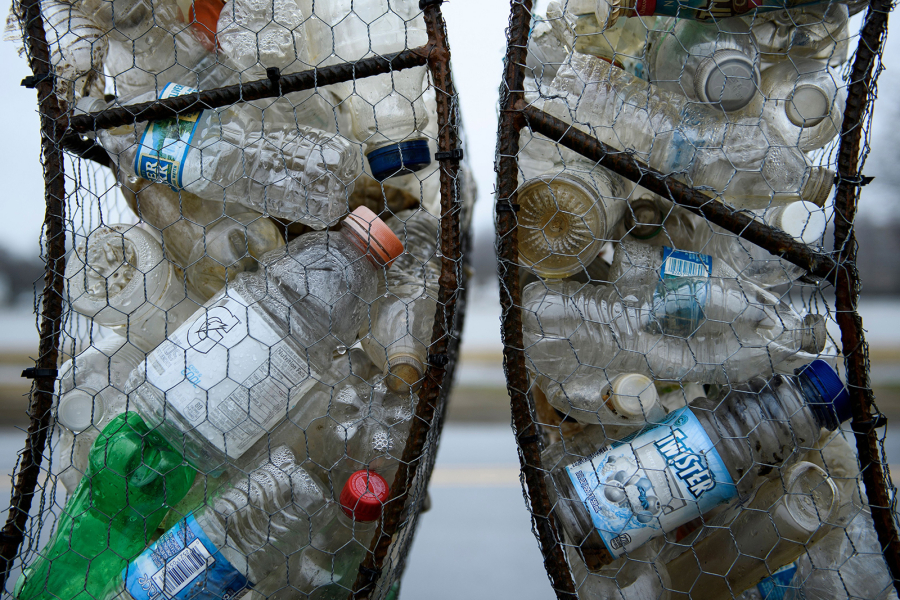PHILADELPHIA — Only 5 percent to 6 percent of the 46 million tons of plastic waste generated annually in the U.S. gets recycled, a big dip from the last estimate of nearly 9 percent just a few years ago, according to a new study by two environmental groups focused on creating awareness around plastic pollution.
The report was released Wednesday, the day New Jersey’s ban on single-use carryout bags went into effect, which one of the authors, Judith Enck, said would bring near immediate change for the state.
“A lot of laws get put into place, and it takes years to see an effect,” said Enck, a former U.S. Environmental Protection Agency official and current visiting professor at Bennington College in Vermont. “You will see literally in the next few months less litter, like bags in trees and on streets, because of the New Jersey plastic bag law. There’s going to be a visible difference.”
Enck is also with Beyond Plastics, a Bennington College-based group formed in 2019 seeking to build an “effective anti-plastics movement.” Beyond Plastics paired for the study with The Last Beach Cleanup, a California-based nonprofit formed the same year by Jan Dell, a chemical engineer, to educate the public.
“The current 2021 U.S. plastic recycling rate is estimated to be between 5 percent and 6 percent,” the report states. “Factoring in additional losses that aren’t measured, such as plastic waste collected under the pretense of ‘recycling’ that are burned, instead, the U.S.’s true plastic recycling rate may be even lower.”
Enck said the report fills in a gap left by the EPA’s failure to update its own recycling figures. The agency last reported a recycling rate of 8.7 percent in 2020, but that was based on an estimate of figures from 2018. The EPA did not publish an update as expected in November.
To fill in the gap, the two groups pulled data from the U.S. National Academies of Sciences, Engineering and Medicine and other “waste engineering experts.” The authors say the public generally believes recycling rates are much higher.
Meanwhile, plastic has become pervasive. Consider that Americans generated about 60 pounds of plastic waste per person in 1980, according to the report. By 2018, that was up to 218 pounds — a 263 percent total increase.
In reality, Enck said, most municipalities recycle only Nos. 1 and 2 plastics as labeled on the bottom of containers. Philadelphia (and most municipalities) lists the types of plastics residents can place in recycling bins on their websites.
No. 1 containers are composed of polyethylene terephthalate, known as PET or PETE. It is commonly used to make water and soda bottles. No. 2 containers are composed of high-density polyethylene, or HDPE, and typically are used to make milk jugs, and shampoo and detergent bottles.
However, there are seven types of plastics that can get labeled with the recycling symbol. Residents often commingle those with Nos. 1 and 2 plastics, contaminating loads that sorting facilities can’t bundle for recycling. So contaminated loads usually get bundled for landfills or incineration.
Plastic bags are not accepted for municipal pickup and also jam machinery at recycling facilities. Styrofoam, yogurt, and microwaveable meals containers are all generally not recycled. Flexible plastic packaging, a rapidly growing product used to make sealable granola pouches, big pet food bags, and packaging for hundreds of other products, is also not recyclable.
Enck, however, doesn’t want people to get discouraged. “We absolutely want people to keep recycling,” she said.
Enck notes that paper and cardboard have a recycling rate of about 68 percent. Metals, such as aluminum cans, and glass, such as bottles, also have much higher rates of recycling than plastics, she said.
Americans were lured into thinking their plastics were getting recycled because they were getting shipped to China for so many years, she said. But China stopped accepting American and European plastics in 2018. The countries then began shipping to Vietnam, Thailand and Malaysia, until those countries balked.
Meanwhile, municipalities and haulers have scrambled to find new domestic markets and retool facilities to better sort recycling loads contaminated by nonrecyclables.
“The problem lies not with the concept or process of recycling, but with the material itself. It is plastic recycling that has always failed,” the report states. “Even when millions of tons of waste plastic were still being exported to China each year, plastics recycling never managed to reach 10 percent.
“Despite the stark failure of plastics recycling, the plastics, packaging, and products industries have waged a decades-long misinformation campaign to perpetuate the myth that plastic is recyclable.



